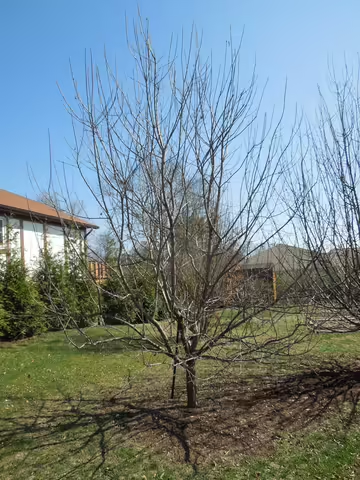URBANA, Ill. – Winter is a great time for orchard owners and fruit tree gardeners to reflect on how their trees are doing and to create a plan for the coming growing season.
When it comes to disease possibilities, tracking seasonal successes and failures helps in the long term.
“Keeping a journal of activities of management and care is essential in caring for fruit trees,” says Andrew Holsinger, University of Illinois Extension horticulture educator. “Using a spray guide provides a reference-based plan for diseases and care of the physiological state of the tree.”
The most effective way to care for tree fruit diseases is for both commercial and homeowner level gardeners to know when to spray fungicides and herbicides. Often, a tree is infected long before symptoms are observed, and prevention is key to tree health, especially with fungal diseases. Fungicide needs to be applied and reapplied to keep trees protected throughout the season.
“Some sprays can only be applied in late winter and early spring to prevent disease before the leaves have emerged,” Holsinger says. “Diseases often develop because a spray wasn’t applied.”
Peach leaf curl is an example of a disease that can easily be avoided by spraying during the dormant season.
Fruit tree disease prevention starts early by choosing disease-resistant varieties. Only plant top-quality, healthy nursery stock to avoid failure. Trees that are stressed are more susceptible to disease and insect pressures. Controlling insects and other pests is important because any wound on trees or fruit is a possible entry point for pathogens.
These apple varieties have disease-resistant characteristics and are good options for Illinois landscapes, or orchards: Crimson Crisp, Dayton, Enterprise, Freedom, Golden Delicious, Gold Rush, Jonafree, Liberty, Priscilla, and William’s Pride. Also consider dwarf or semi-dwarf trees, which are smaller and more easily managed when it comes to disease control and fruit production.
Good tree sanitation is also important in preventing disease. Inspect trees for mummies, which are unpicked, withered, and infected fruits that carry spores, which can cause problems during the next season. Cleaning up fallen leaves and fruits after the harvest is a good practice to reduce the number of fungal spores, especially apple scab, for the next year.
“Pruning is probably the most neglected aspect of disease control,” Holsinger says. “Pruning allows for more air circulation, light penetration, and more adequate spray coverage.”
SOURCE: Andrew Holsinger, Horticulture Educator, Illinois Extension
ABOUT EXTENSION: Illinois Extension leads public outreach for University of Illinois by translating research into action plans that allow Illinois families, businesses, and community leaders to solve problems, make informed decisions, and adapt to changes and opportunities.
PHOTO ACCESS: The photo in this article is available to download for media use.
